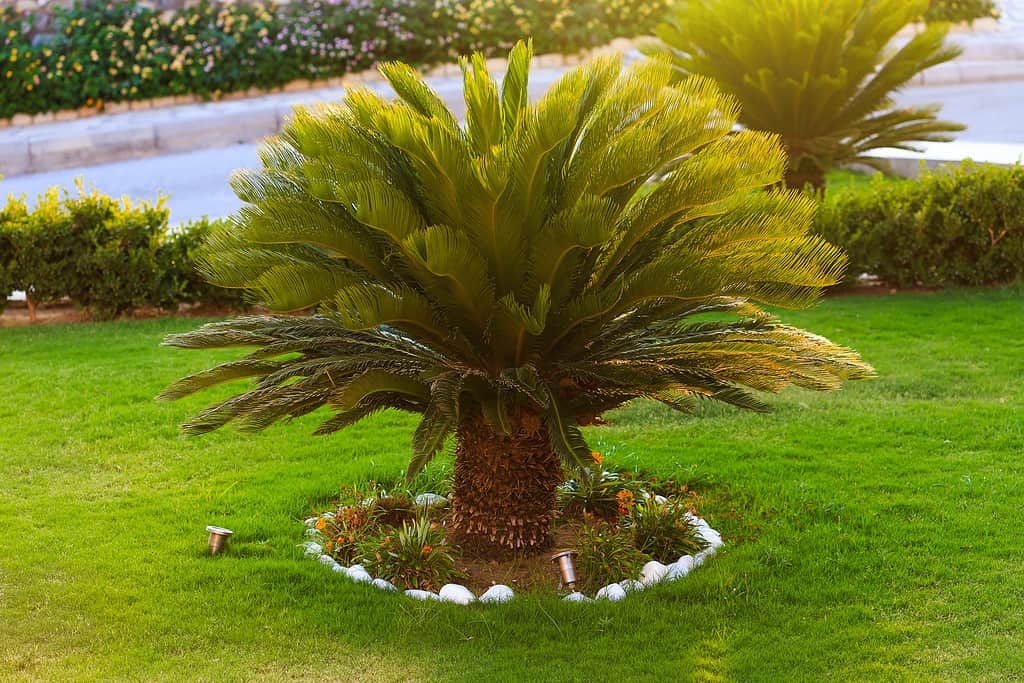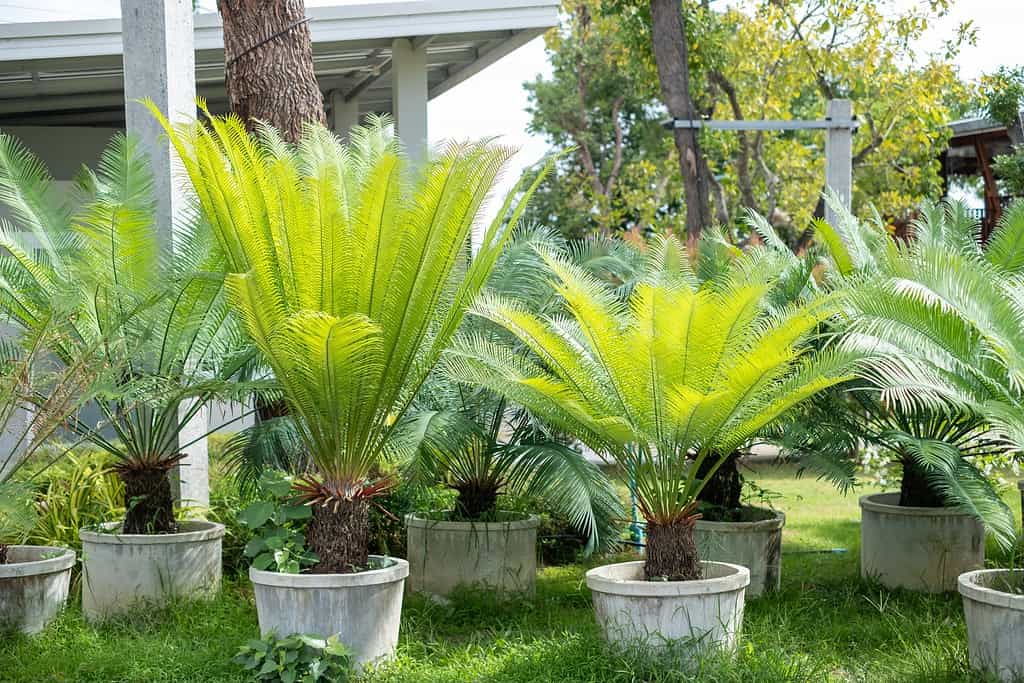The sago palm is an impressive and aesthetically pleasing plant. It is used in a variety of landscaping applications and makes for a wonderful, long-lived, and hardy houseplant. Because of its crisp, symmetrical rosette of leaves, and resemblance to many palms, it gives a stately and tropical feel to wherever it is planted.
If you’re considering growing a sago palm at home, you have many options at your disposal. These plants grow very well indoors and outdoors if given the right environment and are simple to care for. Sagos make great feature plants and are impressive when grown in groups along yard borders. They are also very long-lived and feel right at home when planted indoors.
In this guide, we’ll talk about the growth habits of the sago palm, as well as the conditions that you will need to give your plant for it to thrive.
| Information on Sago Palm Tree | |
|---|---|
| Botanical Name | Cycas revoluta |
| Common Name | Sago Palm, King Sago Palm, Japanese Sago Palm |
| Sunlight | Partial sun. Bright, indirect light. Filtered light under a canopy or behind a curtain is preferred. |
| Water | Moisten the soil but allow the top of the soil to dry out before the next watering. Fairly drought tolerant. |
| Soil Conditions | Must be well-draining. Sandy loam is preferred, neutral, or slightly acidic. |
| Hardiness | USDA zones 9-10. Will die below 15 degrees Fahrenheit. Can tolerate short periods of sub-freezing temps, but foliage damage will likely occur. |
| Indoors or Outdoors? | Great houseplant. Outdoors in the southern U.S. |
| Beginner Friendly? | Yes. Easy to grow in correct conditions. |
What Is a Sago Palm?

Sago palm trees aren’t palm trees. They’re cycads.
©Cristi Kerekes/Shutterstock.com
Although it is referred to as a palm, this evergreen plant is a cycad and behaves more similarly to conifers than palms. Like firs and pines, the sago palm is a gymnosperm and produces seed and pollen cones to reproduce. Although they behave similarly to some other plants, cycads are not directly related to any living plant species — they are ancient plants that are in a grouping all their own.
The sago palm is native to the Japanese island of Kyushu as well as southern China and is widely cultivated as a landscape plant or potted houseplant. While it can reach mature heights of around 10 feet, it can take several decades to do so. Sago palms are very slow growing and stay short and squat, between 2 and 3 feet tall, for long periods of their lifespan.
As they mature, sago palms are capable of producing trunks up to 12 inches in diameter. Each trunk grows in an upright habit and becomes covered in shaggy fibers. Feathery, arching leaves grow from 3 to 7 feet in length and are attached directly to the top of the trunk. They are glossy and rigid and grow symmetrically around the plant’s crown. Each leaf is compound and consists of many narrow, spine-tipped leaflets that grow to 7 inches long. The margins of the leaves are revolute, or rolled down, earning this plant its species name revoluta.
How Do Sago Palms Reproduce?

Because they can’t self-fertilize, sago palms are dioecious.
©pinholeimaging/Shutterstock.com
Sago palms are dioecious, which means that each plant is sexually distinct and is unable to self-fertilize. Male plants may produce one or more large, upright pollen cones that are 12–18 inches in length. Each one is a creamy yellow color and resembles a pine cone. Female seed heads appear feathery and are wider and rounder. If pollen from a male cone reaches a female cone, it will bear many walnut-sized seeds. These seeds are then dispersed by birds and mammals. They may also fall to the ground around the parent plant as the female cone disintegrates over time.
Sago palm “flowering” is fairly rare in cultivation. Plants will usually produce cones every few years but only once they reach around 15 years of age. If you are growing multiple sago palms in different locations and wish to help them reproduce, male cones can be cut from the plant and shaken over female seed heads to disperse pollen. Seed production takes a lot of energy. If you’d like to encourage your sago to focus on leaf and trunk growth rather than produce seeds, seed heads can be removed by cutting them at the base. Be aware that even mature sago palms are unlikely to produce cones if kept indoors.
These plants will also reproduce asexually, generating small copies of themselves, called “suckers”, around the base of their trunks. These small suckers can be carefully separated from the parent plant and potted up to produce new sago palms.
How to Grow a Sago Palm

Growing your sago palm trees is very much possible.
©ISEN STOCKER/Shutterstock.com
If you’d like to grow your sago palm at home, you’re in luck. Caring for these plants is a simple, straightforward task. They can be grown outdoors in containers or garden beds or brought inside the home in pots. Regardless of your planting location, the following guidelines will get you started and help you keep your plant happy and healthy.
Hardiness
This plant’s native subtropical environment is best reproduced in humid, southern areas of the United States. It thrives outdoors in USDA zones 9 and 10 where summers are relatively cool and winter temperatures do not fall too far below freezing. If you choose your planting site carefully and protect your plants from the wind, you may be able to grow them outdoors in parts of Zone 8 as well. Similarly, if well-mulched and positioned out of harsh sunlight, these palms may be grown in hotter growing zones.
Indoors, these plants are not particular about temperature and are well-suited for growing in the average room temperature range.
Sunlight
Sago palms need several hours of sunlight a day to stay healthy. Four to six hours of filtered sunlight is usually plenty. Plants can handle longer periods of light exposure, but be aware that harsh, direct sunlight can damage foliage over time. If you are growing your plant indoors, you can place its container near a south-facing window with a sheer curtain.
Water
While these plants require a decent amount of water to keep them happy, they are also fairly tolerant of drought and infrequent watering. It is ideal to water them regularly, however. You can use the surface of the soil as an indicator of when to water. Once the top layer of soil begins to dry out, give your plant a good soak. Be careful not to overwater, however, as sago palms require constant root oxygenation to stay healthy. They are very sensitive to wet soils and are prone to root rot if the soil remains oversaturated.
Soil Conditions
Because sago plants are sensitive to wet conditions, their soil must be extremely well-draining. Sandy-loam soils are ideal for providing adequate drainage as well as enough clay and silt content to supply vital nutrients. A neutral to slightly acidic pH is ideal.
You can help your plant stay healthy by nurturing its soil. A layer of mulch not only helps soil retain moisture but also protects the surface from sunlight exposure, keeping the soil cool and fostering the growth of vital microbial populations.
These microbes break down the mulch over time, feeding your plant. When it comes to fertilizing, avoiding chemical fertilizers is a good plan. You can supplement your plant’s nutrition by adding thin layers of organic compost or well-rotted animal manure a couple of times per year.
Pests and Disease

Pests can target sago palm trees. Mealybugs are just one that will do so.
©iStock.com/ViniSouza128
Mealybugs and scale insects are the most commonly encountered pests. These insects feed similarly to aphids, piercing the leaf tissue of the plant and consuming the sap. They are not microscopic and can be seen with the naked eye. If a large infestation occurs, the leaves of your sago palm may begin to turn yellow or die back entirely. In extreme cases, insect infestation can kill the entire plant. Infestations are easy to spot, however, and can be dealt with before extensive damage occurs. Indoors, lower humidity can encourage spider mite infestation. Spider mites populations can be combated by wiping down infested foliage or spraying the plant down with warm water. Use a strong, directed spray of water to ensure that insects are removed.
The photo featured at the top of this post is © pinholeimaging/Shutterstock.com
Thank you for reading! Have some feedback for us? Contact the AZ Animals editorial team.







